I received Aran Goyoaga’s Cannelle et Vanille yesterday in the mail, which, on the surface, has nothing to do with Russian pirozhki, but hear me out. It’s a beautiful book, just like everything Aran does. It’s full of nourishing recipes and gorgeous photos of a dinner table decorated with candles and flowers, kitchen shelves lined with mason jars full of grains, and close-ups of essentials like almond milk and cultured butter, both made from scratch. The tableware is handmade ceramics, table clothes are linen, pots are copper.
Just flipping through pages and absent-mindedly following the pictures with my eyes calms my racing mind and almost physically slows the world around me too. And when I start reading, the words turn into vivid images. Here’s 3-year-old Aran in the kitchen, tiptoeing on a chair, watching how her grandmother pasteurizes raw milk. Learning from a grandmother, who on top of being a grandmother (which already entails good cooking skills) was a pastry chef, sounds like the perfect way of dipping your toes into the culinary world.
I want that. The pots, the linens, the long wooden table that can sit eight. Eight of my friends and family members gathered at my cozy sun-lit house (whenever we can actually gather again, at least). I want the memory of my grandmother teaching me how to bake.
Learning from a grandma is romantic, nostalgic, almost a pre-requirement for being a good cook. Pirozhki, for instance, are a perfect food to learn from your grandmother, if you are Russian that is. Rarely a phrase is uttered that has the word pirozhki, but not the word babushka (Russian for grandmother) in it. My grandma Tonya often had an enamel pot filled with pirozhki and covered by a tea towel to keep them warm, when I came to visit. That and a bowl of vinegret. Boy, did she love vinegret! She didn’t love to cook, though. Neither of my grandmothers did.
Babushka Tonya and I baked cookies a few times, and I was assigned the task of cutting hearts and stars of the dough with cookie cutters. But that’s about as far as my culinary apprenticeship went.
I learned to cook by myself, out of necessity, by trial and error. Not one of my kitchens had copper pots or marble countertops. In fact, my current kitchen features faux-wood countertops, a fridge the size of a shoe box, and no space for a chair, let alone a dining table.
But a girl can dream, right? Dream that one day that Instagram-worthy aesthetic of handmade ceramics and freshly-cut flowers will become her reality. That slow life and slow food will be her guiding principles. That one day she’ll have the time and energy to make her own almond milk and churn her own cultured butter, without a one-year-old holding on to her leg and crying. One day, the one-year-old will turn into a three-year-old and she will put him on a chair so he can reach the countertop, and let him crumble flour with softened butter until it becomes sandy, and ask him to pinch the edges of pirozhki together. And then, even though she doesn’t have the memories of a mother or a grandmother teaching her how to cook, she might become part of someone else’s memory. And that may be even better.
How to Make Russian Pirozhki
In order to make pirozhki — in the absence of a babushka that is — one needs enriched yeasted dough, a sweet or savory filling and an important decision to make: to bake or to fry.
The dough I use for pirozhki is enriched with butter, an egg and an extra egg yolk. It comes together fast, is a pleasure to work with once it’s proofed and produces a beautiful crumb, when baked.
The fillings for pirozhki vary greatly from cabbage to liver to berries, but the three fillings I offer below are arguably some of the most popular: spring onion and egg, meat and rice, potato and onion. I’ve made slight modifications to each of the fillings, but you won’t stray too far from the traditional pirozhki recipe, don’t worry.
Spring onion, ramps and egg pirozhki
This filling always brings to mind summer and three-day-long trips to the south of Russia by train. At the stations in big cities, the passengers would spill out of the train to the platform and line up to a babushka selling freshly-made pirozhki. They were still hot, often wrapped in newspapers, and so good to eat once you hop back on the train right when it’s about to leave the station.
The only change I’ve made is adding ramps, just because it is the season and I use it everywhere: from green shchi to eggplant rolls to pancakes. If you can’t get your hands on ramps, replace it with more spring onion.
Spiced meat and rice pirozhki
What separates this version of pirozhki from the traditional one, believe it or not, is the word spiced. Russian cuisine relies almost exclusively on salt and black pepper, when it comes to spices. But I decided to go wild and add cumin, cinnamon, allspice, and nutmeg, inspired by Diana Henry’s recipe for Turkish kofte from her book How to Eat a Peach. There’s also mint and parsley!
Potato, caramelized onion and Parmesan pirozhki
Arguably, the most popular filling for pirozhki, ever. Second, maybe, only to pirozhki with cabbage, but that’s a whole other story.
Parmesan is not commonly used as a filling for Russian pirozhki, but I find adding cheese to pretty much any dish is justified and doesn’t require an explanation.
Fried Pirozhki or Baked Pirozhki?
A matter of taste, of course, (and of how many calories you are willing to consume) but I prefer mine fried, almost every time (my husband, however, prefers baked, so I often end up frying half and baking half). I included directions for both baking and frying pirozhki in the recipe so you can decide for yourself.
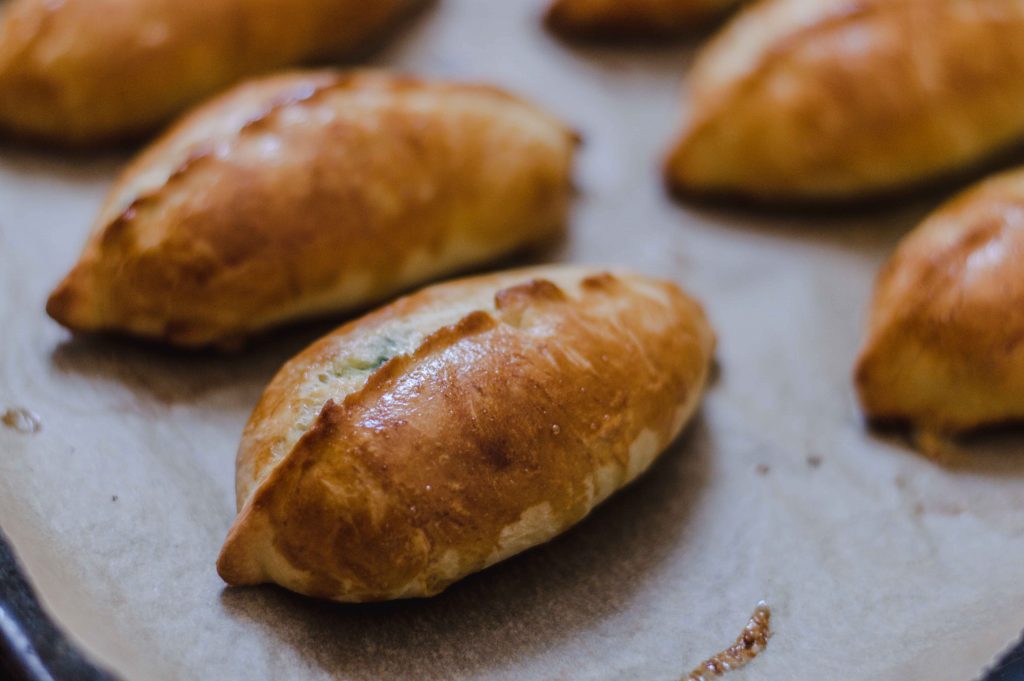
Last, but Not Least: Pirozhki or Piroshki?
That’s rather easy, actually. Depending on whether you transcribe or transliterate the word pirozhki from Russian, the spelling will change. The “zh” in pirozhki comes from transliteration, meaning that every Russian letter in the word is converted into a corresponding English letter. Russian “ж” (pronounced like “g” in Geneva) is usually written as “zh” in English.
Piroshki, on the other hand, is a transcription, meaning that it’s an effort to write the word as it actually sounds. The letter “ж” gives “sh” sound in this particular word.
I stick to my pirozhki, but you are free to use either. The most important thing to remember is that pirozhki are plural (singlular is pirozhok), so no pirozhkis, please!
Russian Pirozhki
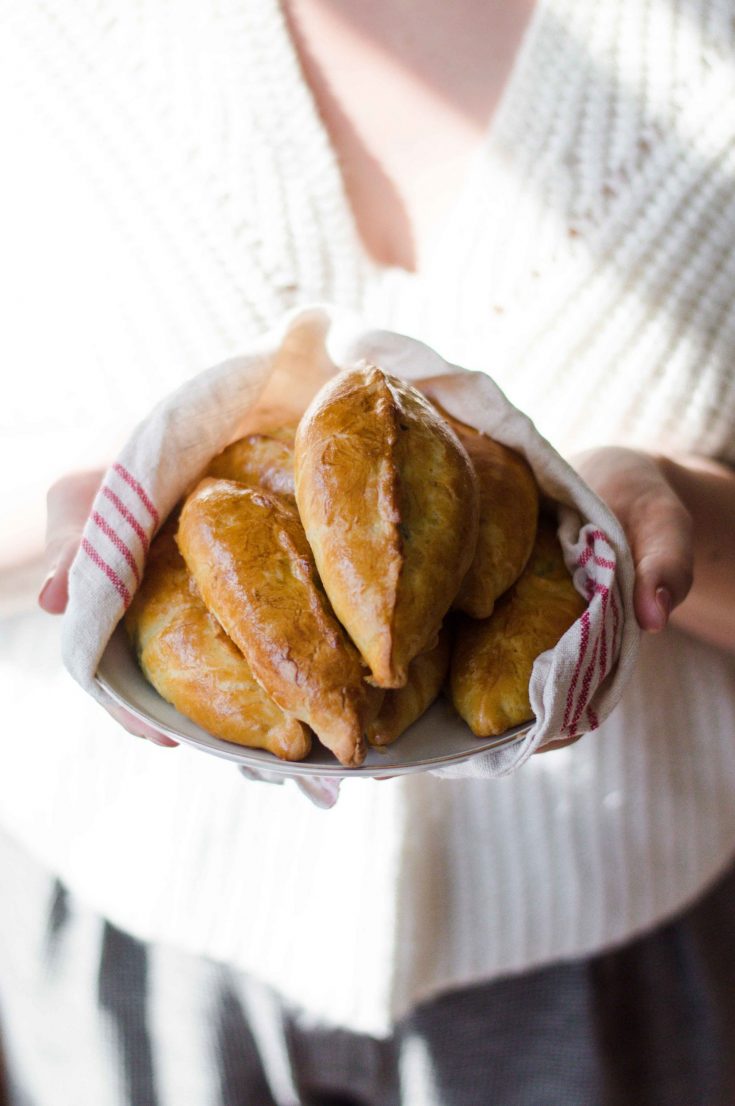
Russian pirozhki (also spelled piroshki) are hand pies made of enriched yeasted dough with a sweet or savory filling inside. In this recipe, I'll show you how to make some of the most popular pirozhki: with spring onion and egg, with meat and rice, and with potato and onions.
Ingredients
For the dough
- 1 tablespoon sugar
- 1 1/2 teaspoons active yeast
- 200 ml (3/4 cup + 1 tablespoon) lukewarm milk, divided
- 1 egg + 1 egg yolk
- 100 grams (7 tablespoons) butter, melted
- 1/2 teaspoon salt
- 430 grams flour (3 cups +1/4 cup + 1 tablespoon)
For the spring onion, ramps and egg filling
- 160 grams (4 cups, lightly packed) chopped ramps
- 140 grams (2 cups) chopped spring onion
- 5 large eggs, hard-boiled, peeled and grated
- 4 tablespoons sour cream
- 1/3 teaspoon salt
- A good grind of black pepper
For the spiced beef and rice filling
- 4 tablespoons of extra virgin olive oil, divided
- 1 large onion (120 grams/ 1/4 pound), peeled and chopped
- 225 grams (1/2 pound) ground beef
- 1 medium garlic clove, minced
- 1/2 teaspoon salt
- 1/4 teaspoon cumin
- 1/8 teaspoon cinnamon
- 1/8 tsp allspice
- A good grind of black pepper
- A good grind of nutmeg
- 30 grams/1 ounce (1 small bunch) of mint, chopped
- 30 grams/1 ounce (1 small bunch) parsley, chopped
- 175 grams (1 cup, tightly packed) cooked rice
For the potato, caramelized onions and Parmesan filling
- 2 large potatoes (500 grams/1.1 pound), peeled
- 1/2 teaspoon salt
- 20 ml (2 tablespoons) milk
- 2 tablespoons butter, divided
- 1 tablespoon extra virgin olive oil
- 2 large onions (350 grams/0.75 pound), peeled and sliced into thin rings
- 40 grams (1.5 ounces) Parmesan, grated
- A good grind of black pepper
For baking/frying
- 1 egg yolk for brushing (if you are baking pirozhki)
- 200 ml (1 cup minus 2 tablespoons) sunflower oil (if you are frying pirozhki)
Instructions
Make the Dough
In a bowl, mix together sugar and yeast, then add 60 ml (1/4 cup) lukewarm milk and whisk until the sugar and yeast are dissolved. Leave, covered, in a warm place for 15 minutes, until frothy and bubbly.
In a big bowl, whisk together 1 egg, 1 egg yolk, the rest of the milk, butter and salt. Whisk in the yeast mixture, once it’s frothy. Add flour, one cup at a time and keep whisking. When the dough becomes too thick for the whisk, use your hands. Mix the dough until the ingredients are just combined and form a ball. Tip the dough onto a surface dusted with flour and knead it for just a minute, until it becomes soft and supple.
Grease a bowl large enough to hold the proofed dough with oil. Place the dough inside, then turn it over so both sides are covered with oil. Cover the bowl with a tea towel and leave it in a warm place for 1 hour, until the dough doubles in size.
Make the filling
Spring onion, ramps and egg filling
Combine all of the ingredients in a bowl and mix to get a uniform filling.
Or spiced beef and rice filling
Place a frying pan over medium heat and add 2 tablespoons of olive oil. When the oil is hot, add the onions and sauté them for 5 minutes, until they are translucent, but not browned.
Add the ground beef, garlic, salt, cumin, cinnamon, allspice, nutmeg and black pepper. Fry, stirring and breaking the meat into small pieces with a wooden spoon, for 10-12 minutes, or until it’s cooked through and there are no streaks of pink. Mix in 2 tablespoons of olive oil, the chopped mint and parsley, and the cooked rice. Take off the heat, taste and adjust salt if needed.
Or potato, caramelized onions and Parmesan filling
Cut peeled potatoes into 6 pieces each, place in a pot and cover with cold water. Bring water to a boil over medium high heat, add the salt, reduce the heat to low and let it simmer for 20 minutes, until potatoes are completely cooked through and a knife can be easily inserted into it. Take the potatoes out and mash them, using a fork or a potato masher. Do not use a blender because it makes the filling too smooth. Yes, too smooth is not always a good thing. Mix in the milk and 1 tablespoon of butter.
Place a frying pan over medium heat and add 1 tablespoon of olive oil and 1 tablespoon of butter. When the oil is hot, add the onions. Fry them over medium heat for 20 minutes, mixing every 2 minutes at first and then every 1 minute. The onions will become translucent first and then will start to caramelize slowly. The trick is to give them the time to brown, but not too much so they burn. Sprinkle a pinch of salt on the onions a few minutes before taking them off the heat. In a bowl, combine the mashed potatoes, the caramelized onions, Parmesan and a grind of black pepper. Taste and adjust salt, if needed.
Assemble pirozhki
Line a baking tray with baking paper.
Once the dough has doubled in size, punch it down and transfer to a surface dusted with flour. Divide the dough into two and leave one half in a bowl, covered with towel to prevent it from drying out.
Divide the other half into 8 equal pieces. With your hands, pat each piece of dough into an oval, approximately 11x7 cm (4x3 inches). Place 1 heaped tablespoon of the filling in the middle, then bring the long sides of the oval to the center and pinch them together, going from the center towards the ends of the pirozhok. Place it on the baking tray. Repeat to the rest of the dough. Once all the pirozhki are ready, cover them with a towel and leave in a warm place to proof for the second time, for about 30 minutes, until they puff up.
Bake pirozhki
Preheat the oven to 200°C (390°F). Brush the pirozhki with egg yolk and place them in the middle of the oven for 15 minutes, until golden brown.
Serve pirozhki hot with a cup of sweetened black tea or a glass of milk.
Or fry pirozhki
Prepare a plate lined with a paper towel.
Pour sunflower oil into a dutch oven (or a heavy-bottom pan) until it’s about 1.5 cm (1/2 inch) high. You need enough oil so when you put a pirozhok in, the oil covers half of it. Place the dutch oven over medium heat. To check if the oil is hot enough, insert the end of a wooden spoon into it. If the oil starts bubbling around the spoon, you are good to go.
Carefully place pirozhki, seam down, into the hot oil, leaving some space between them. My dutch oven is 22 cm (8.5 inches) and I fry 4 pirozhki at a time. Let them fry for 2 minutes, until they turn golden brown, then flip them on the other side and fry for 1 more minute (Start checking if they turned golden a bit earlier to avoid burning them).
With a slotted spoon take pirozhki out and place them on a plate, lined with paper towel. Remove any extra oil with more paper towels. Repeat to the rest of pirozhki.
Serve pirozhki hot with a cup of sweetened black tea or a glass of milk.



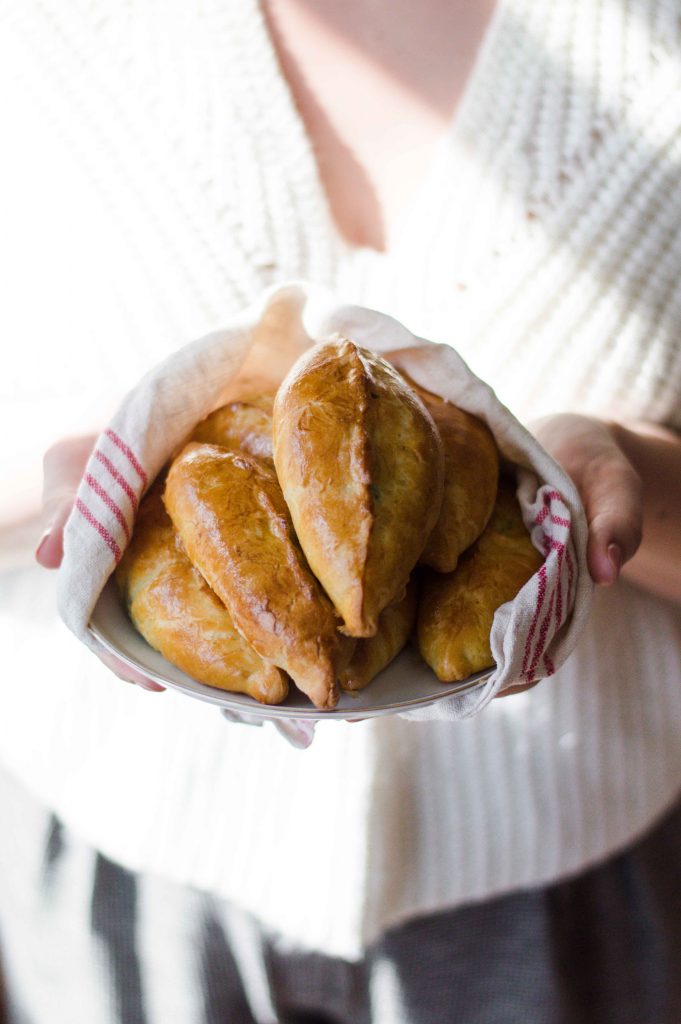

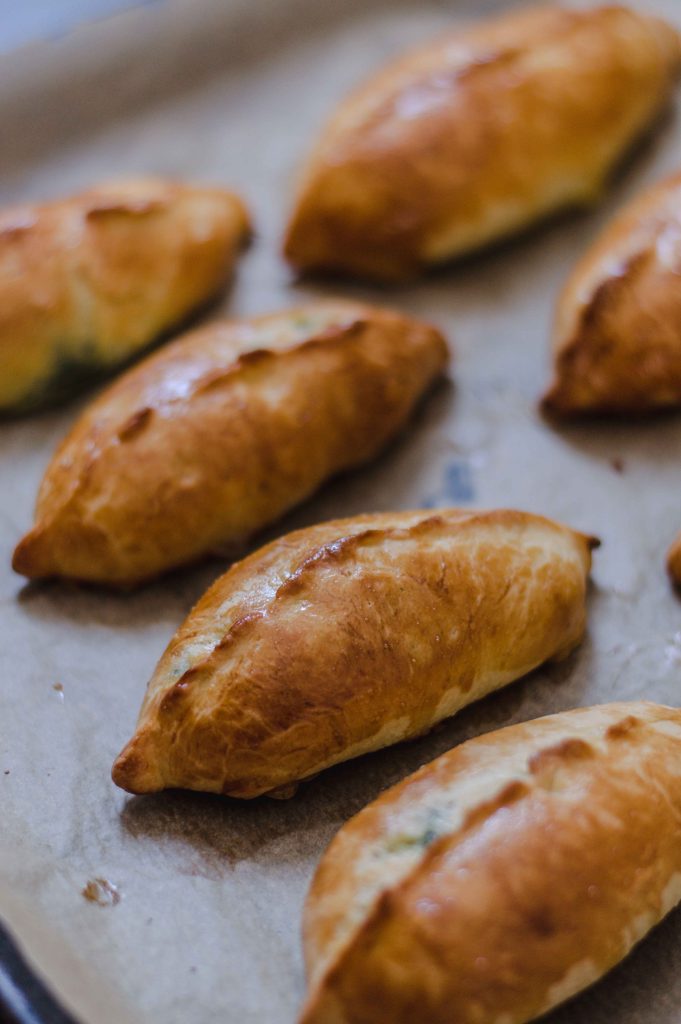


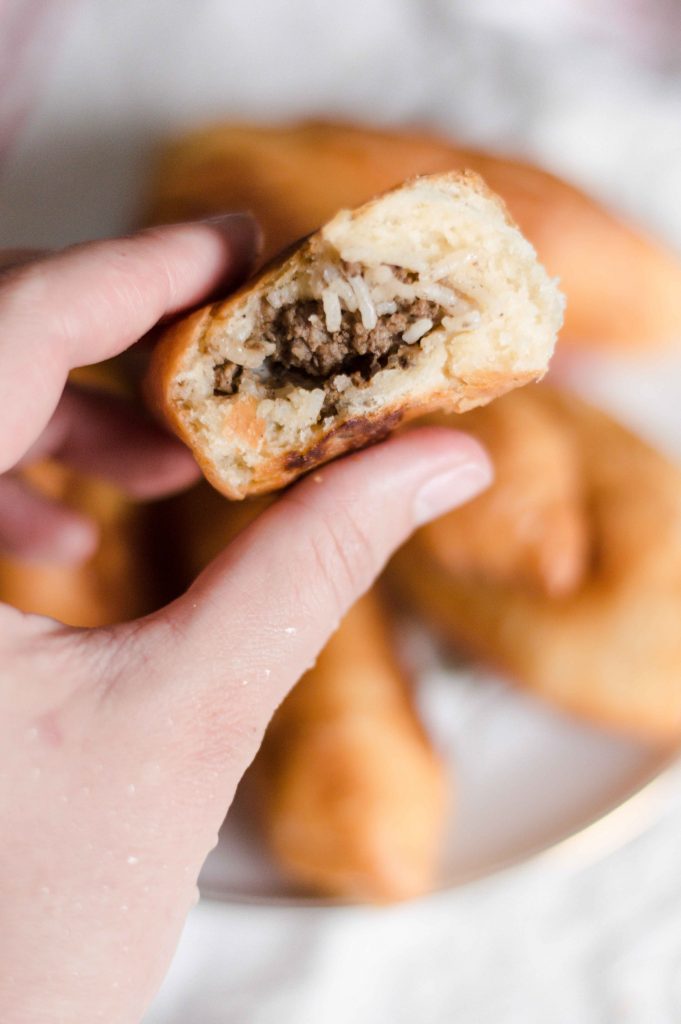

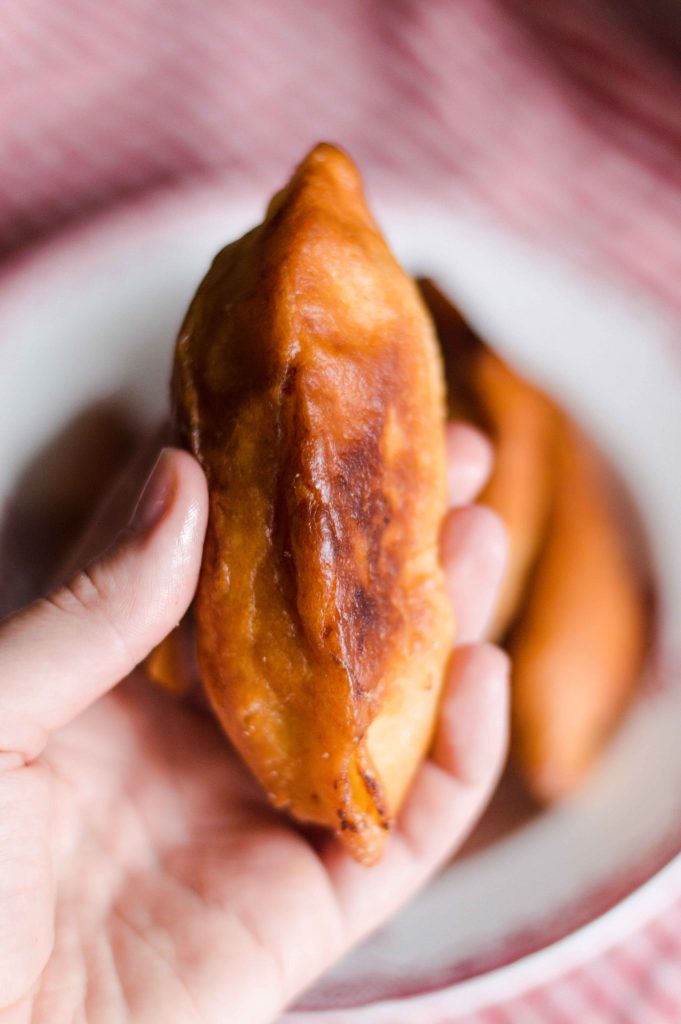
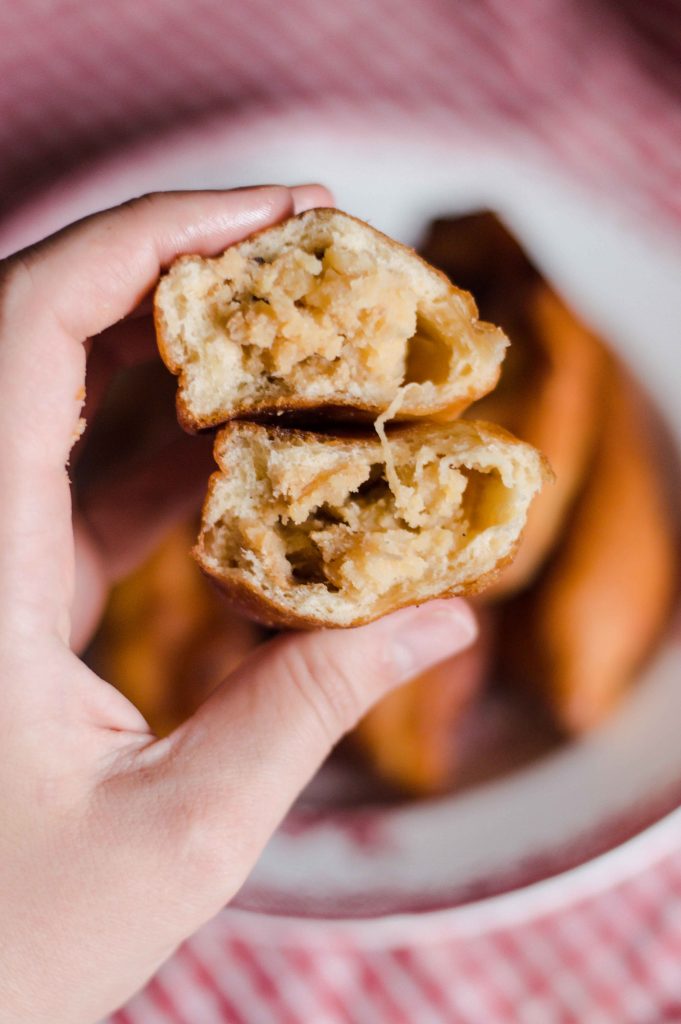
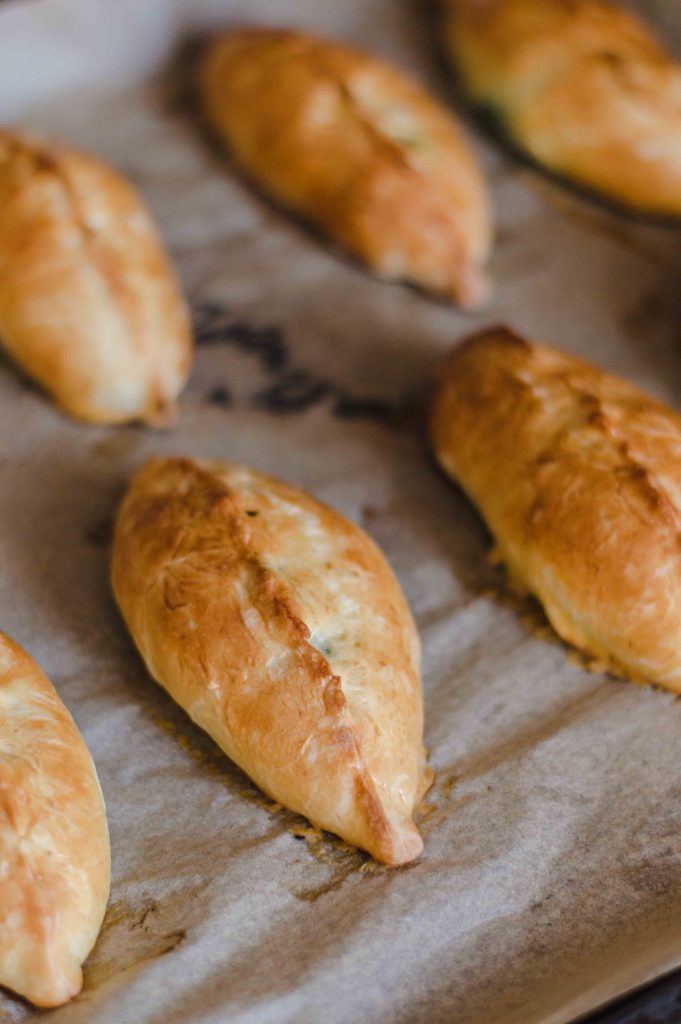
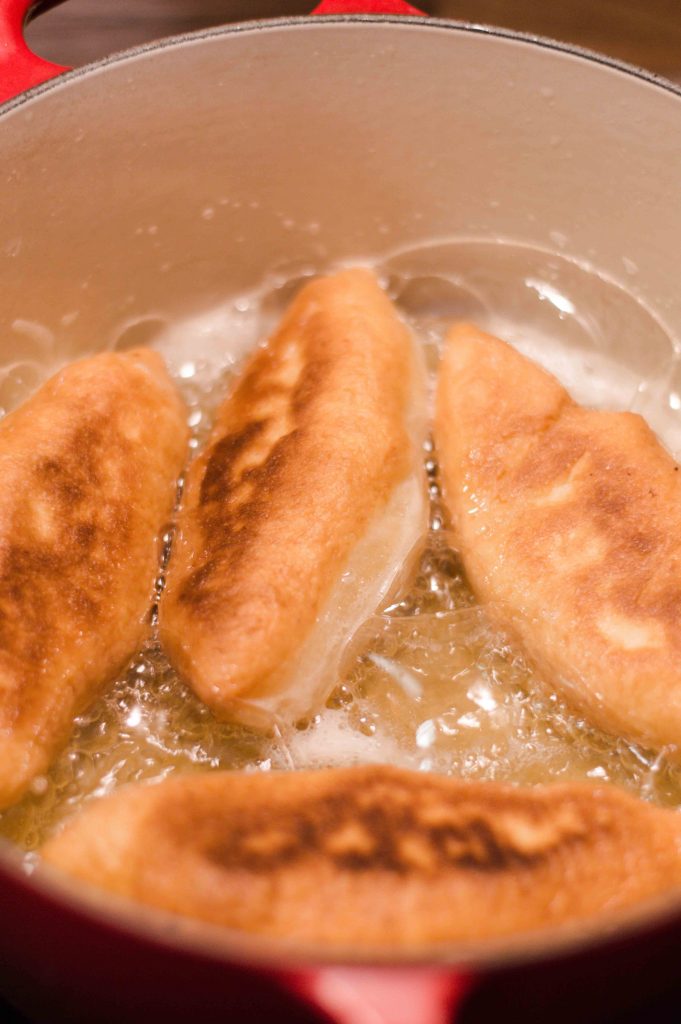




Thank you so much for this recipe, I made the potato filling version for a friend who studied in Russia, and had a nostalgic craving for Pirozhki, I and was told it was the closest remake he’s had since he left. Couldn’t find a news paper to wrap i it for the authentic experience, nevertheless he loved every bite of it.
Oh how sweet! Thank you for trying it out and for the lovely comment!
Dear Yulia,
I grew up in the kitchen of my grandmother. She was born in Russia in 1896 and lived in Vladivostok where she was able to leave during the Revolution. My favorite Russian Food was Pirozhki, and she made several kinds but my memory always falls back on the savory ground beef with onion and spices and etc’s. She would bake them in the morning and we would eat them at lunch, for snacks after school and any old time. I recently found the cookbook that her mother gave her when she left, and I was surprised to find that Google Translate could actually read the Pre-Revolution alphabet with all of the extra letters! Not only that but it also translated the strange measuring units and turned them in to tablespoons, cups, etc ! I am going to try your recipes as they seem to be more what I am looking for right now.
Dear John!
First of all, I am sorry for such a late reply! Since I’ve had my two boys, keeping up with the blog has been an uphill battle))) But I am trying! Thank you for sharing your story with me, how amazing that you have a cookbook written by your great grandmother, that is a real relic and treasure. I am also surprised Google Translate would know pre-revolution alphabet – the technology these days is mind-blowing! Do let me know how pirozhki turned out! I would love to hear from you!
Yulia